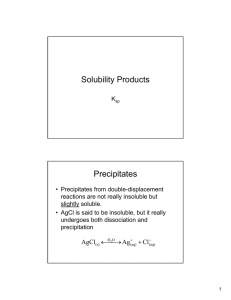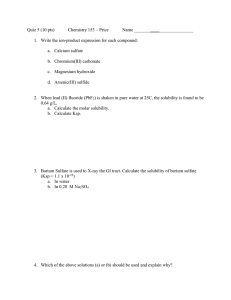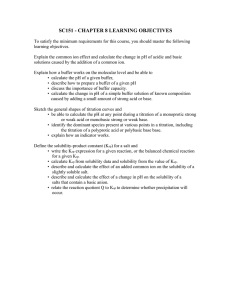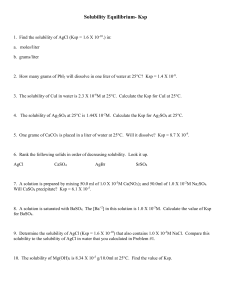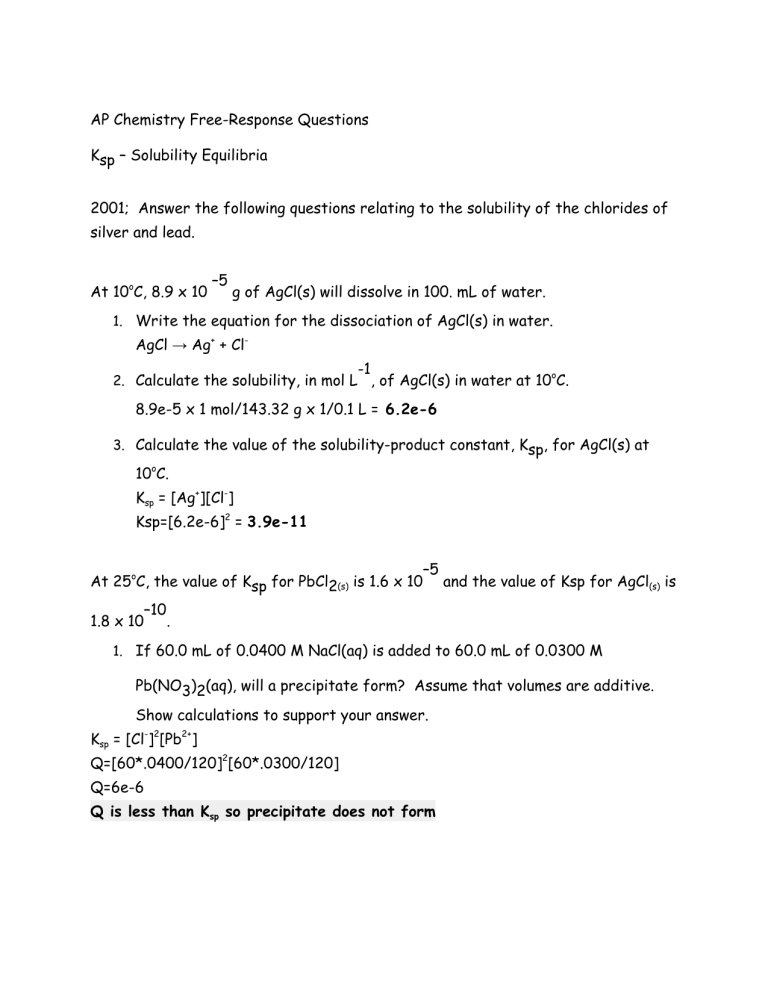
AP Chemistry Free-Response Questions Ksp – Solubility Equilibria 2001; Answer the following questions relating to the solubility of the chlorides of silver and lead. At 10oC, 8.9 x 10 –5 g of AgCl(s) will dissolve in 100. mL of water. 1. Write the equation for the dissociation of AgCl(s) in water. AgCl → Ag+ + Cl-1 o 2. Calculate the solubility, in mol L , of AgCl(s) in water at 10 C. 8.9e-5 x 1 mol/143.32 g x 1/0.1 L = 6.2e-6 3. Calculate the value of the solubility-product constant, Ksp, for AgCl(s) at 10oC. Ksp = [Ag+][Cl-] Ksp=[6.2e-6]2 = 3.9e-11 –5 At 25oC, the value of Ksp for PbCl2(s) is 1.6 x 10 and the value of Ksp for AgCl(s) is 1.8 x 10 –10 . 1. If 60.0 mL of 0.0400 M NaCl(aq) is added to 60.0 mL of 0.0300 M Pb(NO3)2(aq), will a precipitate form? Assume that volumes are additive. Show calculations to support your answer. Ksp = [Cl-]2[Pb2+] Q=[60*.0400/120]2[60*.0300/120] Q=6e-6 Q is less than Ksp so precipitate does not form 2. Calculate the equilibrium value of [Pb 2+ (aq) ] in 1.00 L of saturated PbCl2 solution to which 0.250 mole of NaCl(s) has been added. Assume that no volume change occurs. 1.6e-5=[0.250]2[Pb2+] (x is negligible bc it’s saturated) Pb2+ = 2.56e-4 M https://www.anderson.k12.ky.us/Downloads/Solubility%20Equilibrium%20Quiz% 20I%202001%20Q1%20KEY.pdf 3. If 0.100 M NaCl(aq) is added slowly to a beaker containing both 0.120 M AgNO3(aq) and 0.150 M Pb(NO3)2 (aq) at 25oC, which will precipitate first, AgCl(s) or PbCl2(s)? Show calculations to support your answer. Dilution same for both 1.6e-5 = [0.150][Cl-]2 1.8e-10 = [0.120][Cl-] For PbCl2, [Cl-] = 0.0103 For AgCl, [Cl-] = 1.5e-9 AgCl will form first because the needed [Cl-] to form equilibrium is less than what is needed for PbCl2. 1998: Solve the following problem related to the solubility equilibria of some metal hydroxides in aqueous solution. –6 The solubility of Cu(OH)2 (s) is 1.72 x 10 gram per 100. milliliters of solution at 25oC. 1. Write the balanced chemical equation for the dissociation of Cu(OH)2 (s) in aqueous solution. Cu(OH)2 → Cu2+ + 2OHo 2. Calculate the solubility (in moles per liter) of Cu(OH)2 at 25 C. 1.72x10-6 g (1 mol / 97.562 g) (1 / 0.1 L) = 1.76e-7 3. Calculate the value of the solubility-product constant, Ksp, for Cu(OH)2 at 25oC. Ksp = [Cu2+][OH-]2 = x(2x)2 Ksp = (1.76e-7)(2x1.76e-7)2 = 2.19x10-20 –17 The value of the solubility-product constant, Ksp, for Zn(OH)2 is 7.7 x 10 at 25oC. 1. Calculate the solubility (in moles per liter) of Zn(OH)2 at 25(C in a solution with a pH of 9.35. 2. At 25(C, 50.0 milliliters of 0.100-molar Zn(NO3)2 is mixed with 50.0 2+ milliliters of 0.300-molar NaOH. Calculate the molar concentration of Zn (aq) in the resulting solution once equilibrium has been established. Assume that volumes are additive. 2+ 1994: In a saturated solution of MgF2 at 18(C, the concentration of Mg is 1.21 3 x 10 molar. The equilibrium is represented by the equation below: MgF2 (s) = Mg 2+ (aq) + 2 F (aq) 1. Write the expression for the solubility-product constant, Ksp, and calculate its value at 18(C. 2+ 2. Calculate the equilibrium concentration of Mg in 1.000 liter of saturated MgF2 solution at 18(C to which 0.100 mole of solid KF has been added. The KF dissolves completely. Assume the volume change is negligible. 3. Predict whether a precipitate of MgF2 will form when 100.0 milliliters of a 3 3.00 x 10 - molar Mg (NO3)2 solution is mixed with 200.0 milliliters of a 2.00 x 10 -3 - molar NaF solution at 18(C. Calculations to support your prediction must be shown. 4. At 27(C the concentrations of Mg 10 -3 2+ in a saturated solution of MgF2 is 1.17 x molar. Is the dissolving of MgF2 in water an endothermic or an exothermic process? Give an explanation to support your conclusion. –3 1990: The solubility of iron(II) hydroxide, Fe(OH)2 is 1.43 x 10 gram per liter at 25(C. 1. Write a balanced equation for the solubility equilibrium. 2. Write the expression for the solubility product constant, Ksp, and calculate its value. 3. Calculate the pH of a saturated solution of Fe(OH)2 at 25(C. 4. A 50.0-milliliter sample of 3.00 x 10 50.0 milliliters of 4.00 x 10 –6 –3 – molar FeSO4 solution is added to – molar NaOH solution. Does a precipitate of Fe(OH)2 form? Explain and show calculations to support your answer.
